Discover the top reasons why Palm Leaf Plates are the ideal eco-friendly choice for your dining needs. Sustainable, biodegradable, and beautifully unique, they offer an unbeatable combination of environmental benefits, health safety, and aesthetic appeal for any occasion. Choose Palm Leaf Plates for a greener, safer, and more stylish dining experience.
Introduction
In today’s eco-conscious world, the shift towards sustainable living is more than just a trend; it’s a necessity. Among the myriad of changes we can adopt, the choice of tableware is a simple yet impactful one. Enter palm leaf plates, a rising star in eco-friendly dining.
What Are Palm Leaf Plates?
Palm leaf plates are eco-friendly, disposable tableware made from the fallen leaves of the Areca palm tree. These plates are produced using a simple yet innovative process that does not involve cutting down trees, making them a sustainable alternative to traditional disposable plates made from plastic or paper. The fallen leaves are collected, cleaned, and then subjected to heat and pressure, which molds them into various shapes and sizes suitable for a wide range of uses, from dinner plates to bowls and serving trays.
This natural production process ensures that palm leaf plates are completely biodegradable and compostable, breaking down in a matter of months when disposed of in a composting environment. This characteristic makes them an ideal choice for those looking to minimize their environmental impact. Additionally, since the manufacturing process does not use chemicals or synthetic materials, palm leaf plates are free from toxins and safe for use with food. They are sturdy and can handle hot, cold, wet, or dry foods, making them versatile for different types of meals and events.
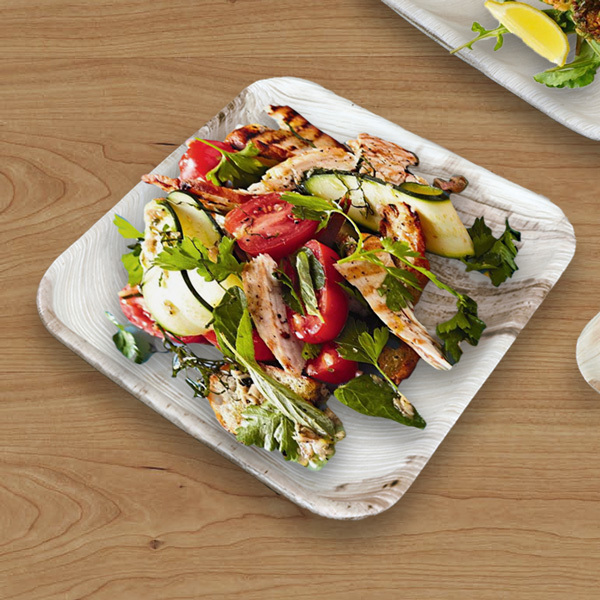
Types of Palm Leaf Plates
- Round Plates: These are the most traditional form, perfect for main courses and available in sizes ranging from small for appetizers to large for full meals.
- Square Plates: Square palm leaf plates offer a modern aesthetic, ideal for contemporary dining settings. They are available in various sizes for different food servings.
- Rectangular Plates: Rectangular plates are excellent for serving snacks, sushi, or desserts. Their elongated shape makes them unique and stylish for table settings.
- Oval Plates: Oval plates combine elegance with functionality, suitable for serving grilled meats, fish, or assortments of appetizers.
- Bowls: Palm leaf bowls are designed for soups, salads, and desserts. They vary in depth and diameter, catering to both individual servings and communal dishes.
- Serving Trays: These larger items are great for buffet lines or family-style dining, allowing for a beautiful presentation of a variety of foods.
- Compartment Plates: Plates with compartments are ideal for meals that include multiple items that need to be kept separate, such as buffet or cafeteria settings.
- Canapé Plates: Small, often intricately shaped plates designed for canapés, hors d’oeuvres, or small bites at cocktail parties or receptions.
Benefits of Using Palm Leaf Plates
- Eco-Friendly and Sustainable: The most significant benefit of palm leaf plates is their environmental sustainability. They are made from fallen leaves of the Areca palm tree, which means no trees are cut down to produce them. After use, these plates biodegrade naturally within a few months, unlike plastic alternatives that can take hundreds of years to decompose.
- Compostable: Palm leaf plates can be composted, turning into nutrient-rich soil that can help grow more plants. This feature aligns with the principles of zero waste and circular economy, where every product’s life cycle is designed to have minimal environmental impact.
- Chemical-Free Production: The manufacturing process of palm leaf plates does not involve any chemicals, making them a safer option for serving food compared to other disposables that may contain harmful substances. This natural process ensures that the plates are free from toxins and safe for everyone, including children and those with chemical sensitivities.
- Durable and Heat Resistant: Despite their natural origins, palm leaf plates are surprisingly sturdy and resistant to heat. They can comfortably hold hot foods and liquids without bending or leaking, making them suitable for a wide range of culinary uses, from serving hot meals to cold desserts.
- Unique and Elegant Design: Each palm leaf plate has a unique texture and pattern, reflecting the natural beauty of the leaf it was made from. This adds an elegant and rustic touch to any dining setting, making these plates a popular choice for weddings, parties, and other events where presentation is key.
- Versatile: Palm leaf plates come in various shapes and sizes, catering to different food types and serving needs. Whether it’s a formal dinner, a casual barbecue, or a catered event, there’s a palm leaf plate suitable for the occasion.
- Microwave and Oven Safe: Unlike many disposable options, palm leaf plates can safely be used in the microwave and even in the oven for short periods at low temperatures, offering convenience for reheating food.
- Supports Rural Livelihoods: The production of palm leaf plates often supports the livelihoods of rural communities where economic opportunities may be limited. By providing a source of income for families in these areas, the palm leaf plate industry contributes to sustainable development goals.
- Cost-Effective: Despite their numerous benefits and sustainable features, palm leaf plates are competitively priced, making them an accessible option for those looking to make environmentally conscious choices without breaking the bank.
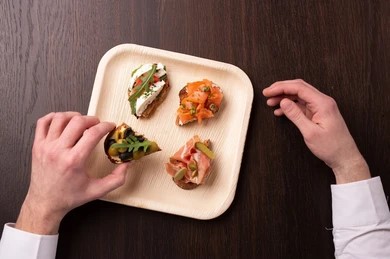
Environmental Benefits
- Biodegradability and Compostability: One of the most compelling environmental benefits of palm leaf plates is their biodegradability. Unlike plastic or styrofoam plates, which can take hundreds of years to break down, palm leaf plates naturally decompose in a matter of months when composted. This rapid breakdown process returns nutrients to the soil, enhancing soil health and supporting the growth of plants.
- Sustainable Resource Use: Palm leaf plates are made from the fallen leaves of the Areca palm tree, which means their production does not necessitate the cutting down of trees or harm to the plant. This sustainable resource use ensures that the natural cycle of life is not disrupted, preserving biodiversity and maintaining ecological balance.
- Reduction in Plastic Waste: By opting for palm leaf plates over plastic alternatives, consumers can significantly reduce their contribution to plastic waste, one of the most pressing environmental issues today. Plastic pollution is a major threat to wildlife, marine life, and ecosystems, and switching to biodegradable options like palm leaf plates can help alleviate this problem.
- Lower Carbon Footprint: The production and disposal of plastic and other non-biodegradable materials contribute significantly to greenhouse gas emissions. In contrast, the manufacturing process of palm leaf plates requires less energy and produces fewer carbon emissions. Moreover, since palm leaf plates are made from naturally fallen leaves, their production has a much lower environmental impact compared to materials that require intensive farming, harvesting, and processing.
- Promotes Soil Health: When composted, palm leaf plates contribute to soil health by adding organic matter that improves soil structure, moisture retention, and nutrient content. This enhancement of soil health is crucial for sustainable agriculture and gardening practices.
- Encourages Sustainable Practices: The popularity and use of palm leaf plates can encourage consumers, businesses, and event organizers to adopt more sustainable practices across other areas of their operations. This ripple effect can lead to broader environmental benefits, including reduced waste, conservation of natural resources, and heightened awareness of sustainability issues.
- Supports Circular Economy: The circular economy aims to minimize waste and make the most of resources. Palm leaf plates fit into this model perfectly, as their life cycle—from natural falling of leaves to biodegradation—creates a closed loop that minimizes environmental impact and promotes the efficient use of resources.

Comparing Palm Leaf Plates to Other Eco-friendly Alternatives
1. Bamboo Plates
- Sustainability: Both palm leaf and bamboo plates are made from renewable resources. Bamboo grows quickly, making it a highly sustainable option. However, palm leaves are a byproduct of already existing trees, requiring no additional resources to grow.
- Aesthetic Appeal: Bamboo plates offer a sleek, uniform look, which might be preferred in more modern settings. Palm leaf plates, with their unique textures and patterns, provide a rustic and warm appearance.
- Durability: Both materials are known for their strength and ability to hold up against heavy foods. Bamboo might have a slight edge in terms of uniformity and resistance to cutting.
- Cost: Bamboo plates can be more expensive due to the processing involved in their production. Palm leaf plates often offer a more cost-effective solution without compromising quality.
2. Sugarcane Bagasse Plates
- Sustainability: Sugarcane bagasse is a byproduct of the sugar industry, making it another eco-friendly material. Like palm leaves, it’s biodegradable and compostable. However, the energy and resources needed to process bagasse into plates can be higher than those required for making palm leaf plates.
- Aesthetic Appeal: Bagasse plates usually have a more uniform and less textured appearance compared to palm leaf plates. The choice between the two often comes down to personal preference for the event or setting.
- Durability: Bagasse plates are suitable for a wide range of foods, including liquids. However, they may not be as leak-proof or as strong as palm leaf plates when dealing with very heavy or hot foods.
- Cost: Bagasse plates are generally affordable, making them a competitive option. However, prices can vary based on quality and brand.
3. Compostable Paper Plates
- Sustainability: Compostable paper plates are made from recycled paper or other fibers and are biodegradable. While they are eco-friendly, the process of recycling paper can be resource-intensive, involving water and energy.
- Aesthetic Appeal: Paper plates offer versatility in design and color but lack the natural, organic look of palm leaf plates. They’re more suited to casual, informal events.
- Durability: While some compostable paper plates are designed to handle a variety of foods, they generally do not offer the same strength and heat resistance as palm leaf plates.
- Cost: Compostable paper plates are often the most economical of the eco-friendly options, but this can come at the expense of durability and presentation.
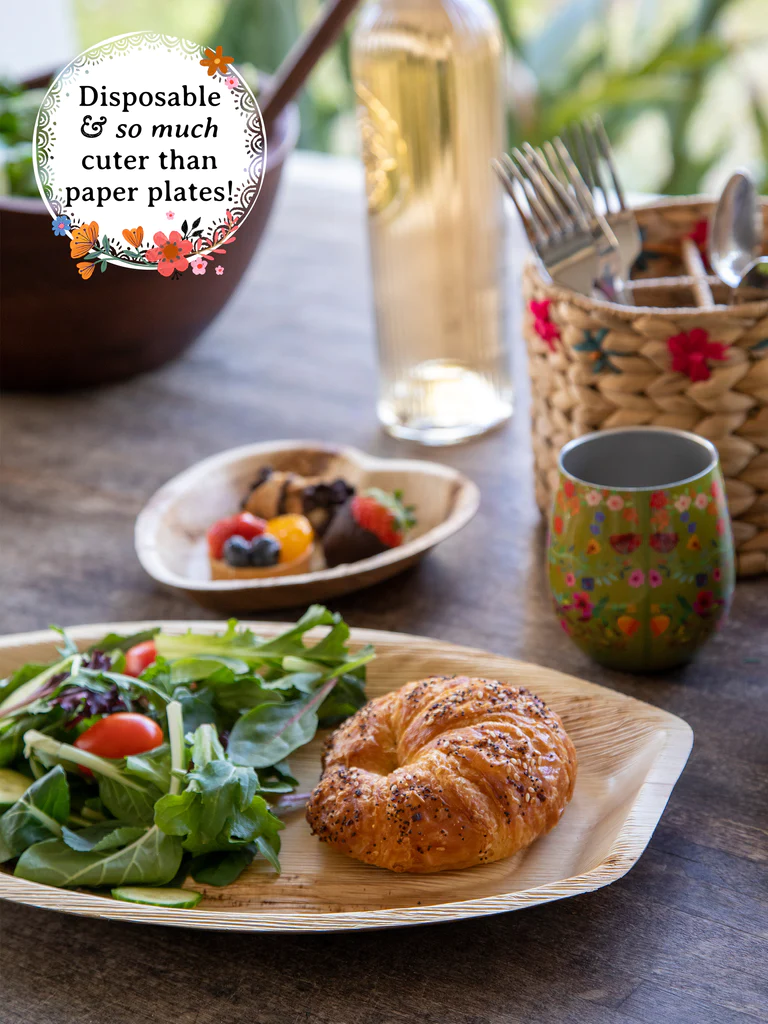
Creative Uses of Palm Leaf Plates
1. Home Decor: Palm leaf plates can be transformed into beautiful pieces of home decor. For instance, they can be painted, varnished, or left in their natural state and mounted on walls as a part of a rustic or bohemian decor theme. Their unique patterns and textures can add an earthy charm to any room.
2. Plant Trays: Their biodegradability makes palm leaf plates excellent candidates for plant trays. Use them under potted plants to catch excess water and soil, adding a natural touch to your indoor garden. As they degrade, they can be composted, reducing waste.
3. Crafting Material: Creative minds can turn palm leaf plates into a base for various craft projects. Cut them into shapes for decorations, use them in scrapbooking, or even as eco-friendly canvases for painting projects. Children can also use them for art projects, making them a versatile and safe material for family activities.
4. Serving Platters: Beyond their use as plates for individual servings, larger palm leaf plates can serve as platters for cheese boards, charcuterie, or appetizers. Their sturdy nature can handle an assortment of foods, making them perfect for gatherings where you want to maintain an eco-conscious approach.
5. Eco-Friendly Gift Wrapping: Smaller palm leaf plates can be used to hold gifts, replacing traditional wrapping paper. Tied up with a biodegradable twine or ribbon, it creates a unique, sustainable gift presentation that stands out and underscores your commitment to the environment.
6. Event Name Tags or Place Settings: For weddings or events, palm leaf plates can be cut into smaller pieces and used as name tags for seating arrangements or as labels for food items on a buffet. They offer a rustic charm and can be easily written on with a permanent marker.
7. Biodegradable Bird Feeders: Create simple, biodegradable bird feeders by coating palm leaf plates with peanut butter and birdseed. Hang them on trees to provide food for birds. Once the food is gone, the plates can be left to decompose or be composted, leaving no waste behind.
8. Disposable Palettes for Painting: Artists looking for an eco-friendly palette option can use palm leaf plates. They’re strong enough to hold paint and can be composted after use, making cleanup easy and environmentally friendly.
9. Natural Disposable Trays for Pet Food: For pet owners who need a quick and easy feeding solution while traveling or on the go, palm leaf plates offer a natural and disposable option. They’re safe for pets and can be composted after use, reducing the use of plastic pet dishes.
10. Packaging Material: For small businesses looking to reduce their carbon footprint, palm leaf plates can be shredded and used as eco-friendly packaging material to protect goods during shipping. This not only repurposes the plates but also provides a unique unboxing experience for customers.
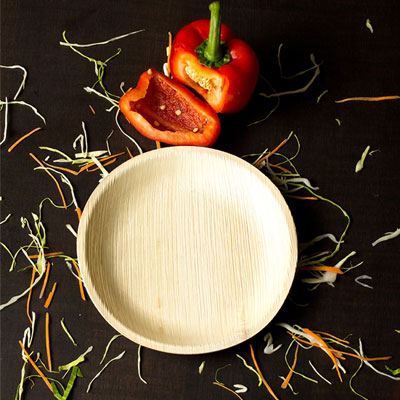
Conclusion
Choosing palm leaf plates is a small but powerful step towards a more sustainable and healthy lifestyle. With their myriad of benefits, from environmental to aesthetic, they are undoubtedly the best choice for anyone looking to make a positive impact on the planet.
FAQs
- Are palm leaf plates reusable? While designed for single use, they are compostable and biodegradable, making them a sustainable choice.
- Can they handle hot food? Yes, palm leaf plates can safely hold hot foods and liquids without leaking or losing shape.
- How long do they take to decompose? They decompose in about 60-90 days in a composting environment, much faster than plastic or even paper.
- Are they microwave safe? Yes, they can be used in the microwave for short periods, making them convenient for warming up food.
- Where can I buy palm leaf plates? They are available online and in many eco-friendly stores, making them easily accessible for anyone looking to switch.

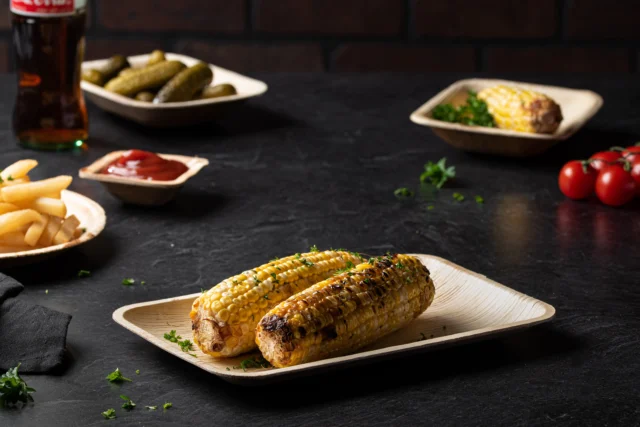

MOST COMMENTED
Animal-Based Proteins / Casein Protein / Dietary Protein / High-Protein Diets / Pea Protein / Plant-Based Proteins / Protein / Protein Deficiency / Protein Supplements / Proteins / Whey Protein / Whey Proteins
Is Protein Powder Safe for Teenagers and Children?
Animal-Based Proteins / Casein Protein / Dietary Protein / High-Protein Diets / Pea Protein / Plant-Based Proteins / Protein / Protein Deficiency / Protein Supplements / Proteins / Whey Protein / Whey Proteins
Unlock the Power of Proteins for Optimal Gut Health
Multivitamin
Total Health: Multivitamin for Active Lifestyles
Multivitamin
WellnessFusion: Complete Multivitamin Support
Dietary Supplement
Revitalize Your Health: The Magic of Red Yeast Rice Capsules
Foot care / Foot Health
Revitalize Your Foot Care Routine: Essential Tips for Optimal Foot Health
Foot Problem / Diabetics / Foot Health
Diabetics: Mastering Footwear Selection for Enhanced Foot Health and Ultimate Comfort
Exercises and Footwear Tips for Hammertoe Relief / Foot care / Foot Health / Foot Pain / Foot Problem / Hammertoes
Unlock Effective Exercises and Footwear Tips for Hammertoe Relief
Hammertoes / Foot Health / Foot Pain / Foot Problem
Unlock Relief: Essential Guide to Hammertoes Causes, Symptoms, and Treatments
Foot Problem / Foot Health
Revolutionize Your Recovery: Natural Remedies for Plantar Fasciitis – Fresh Home Keepers